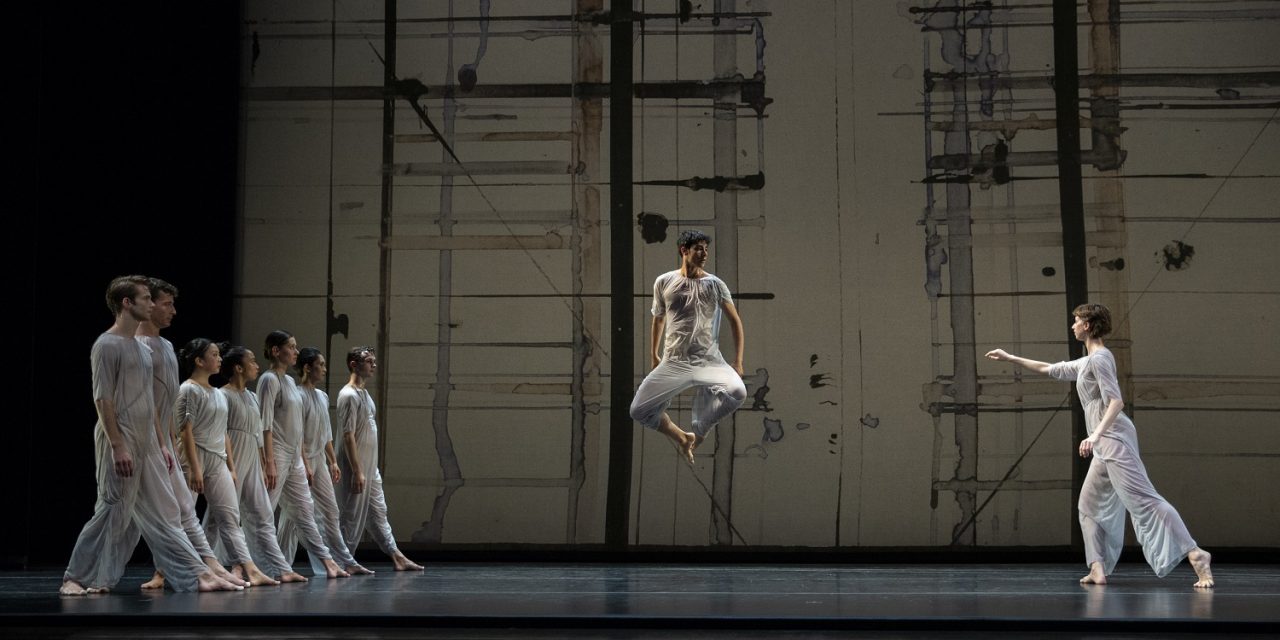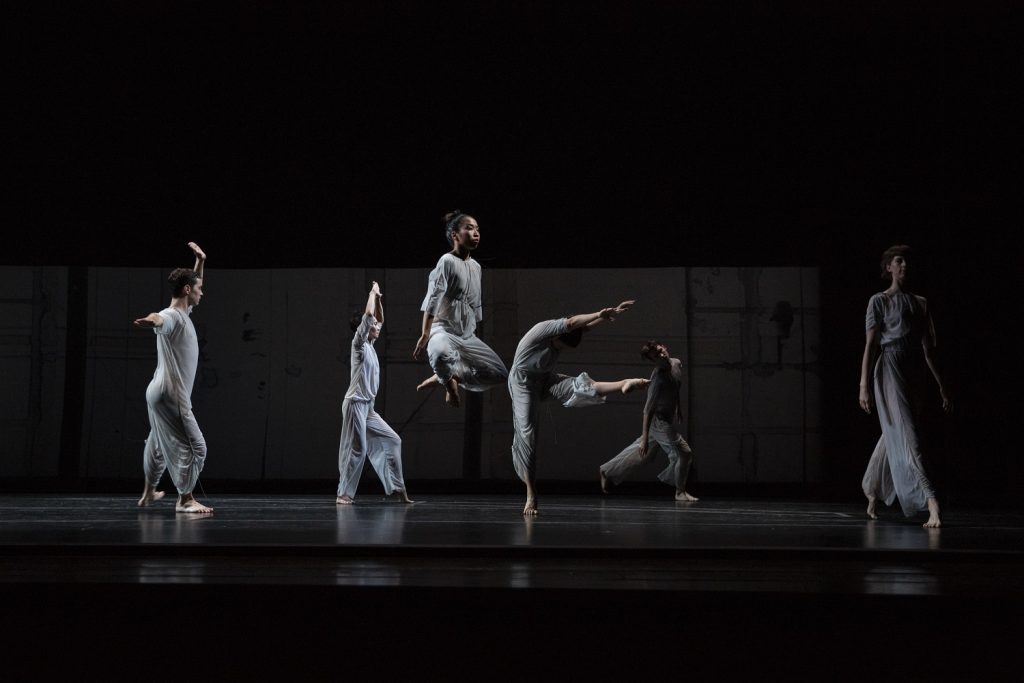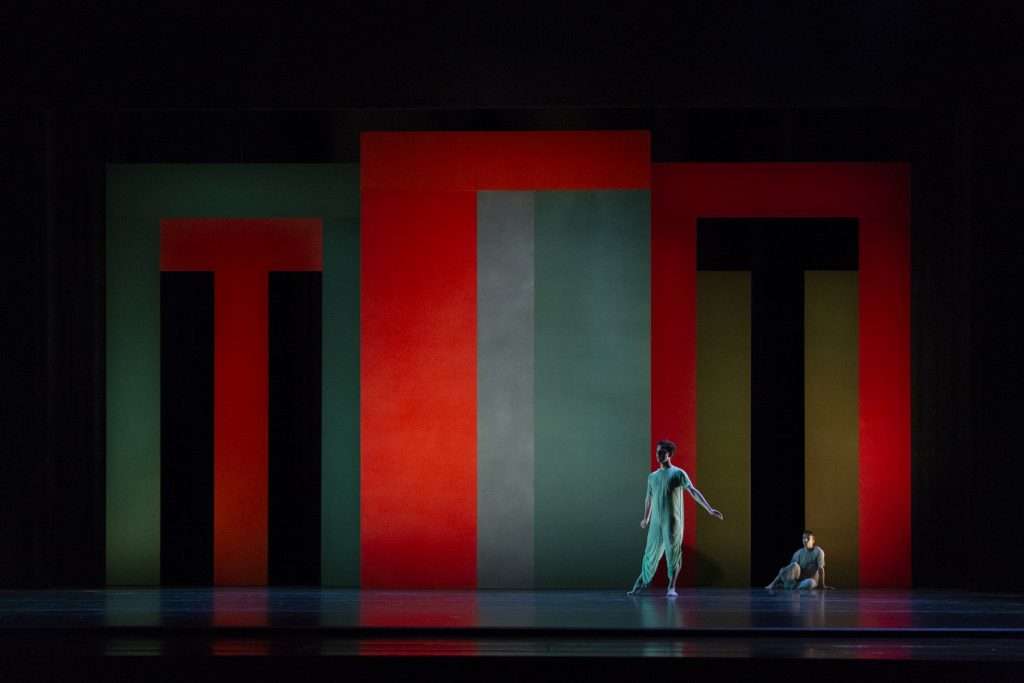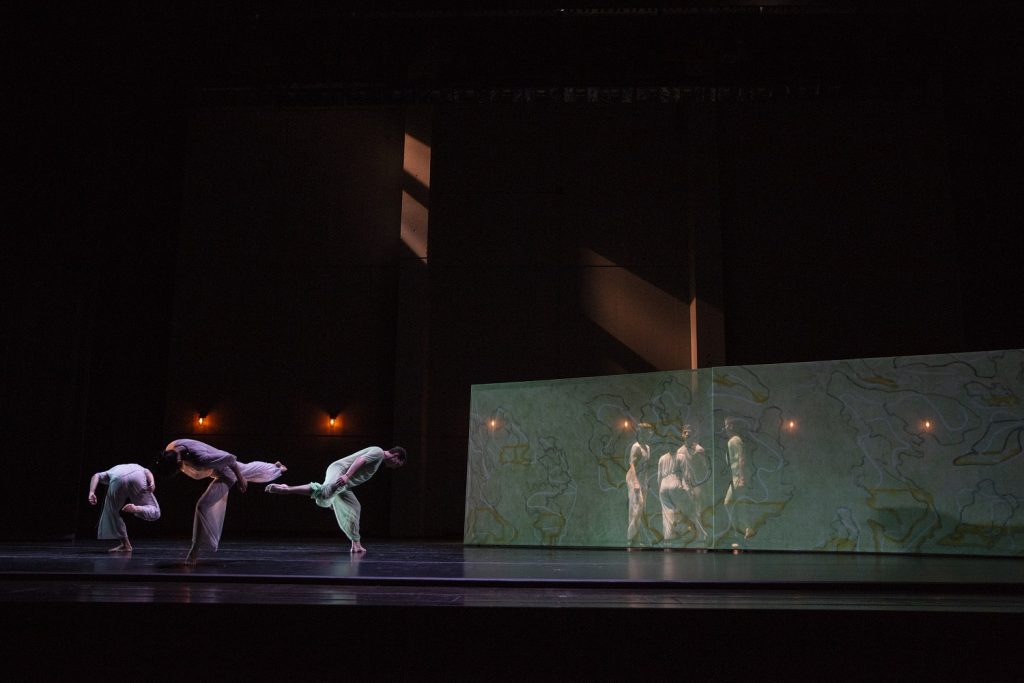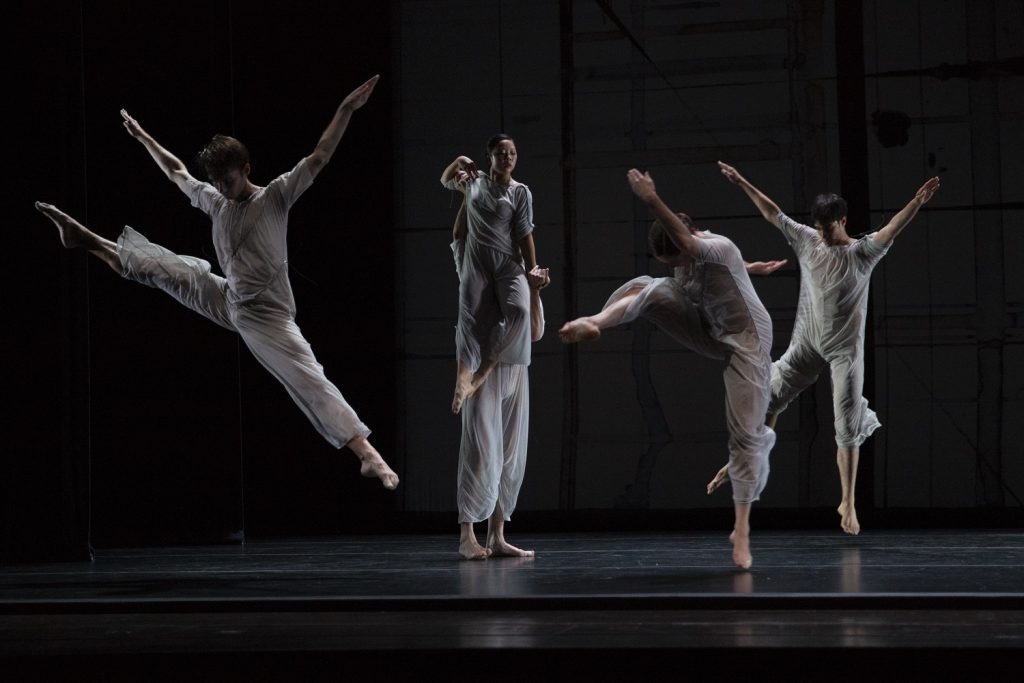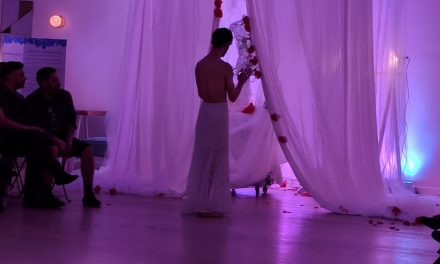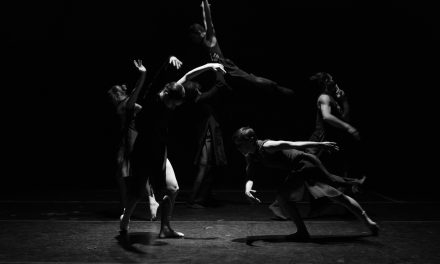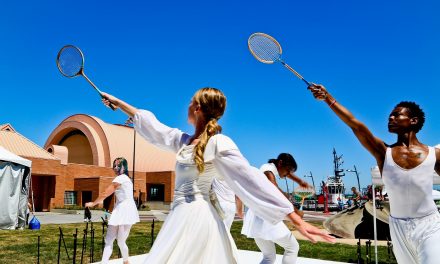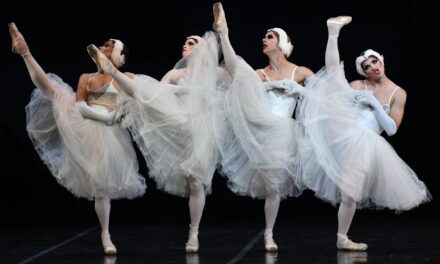Between 1936 and 1942 American poet T. S. Eliot wrote a set of four poems that were published separately by Great British publishing company Faber and Faber. In 1943, Eliot’s US publisher Harcourt was the first to publish them all together under the title Four Quartets. These four poems titled “Burnt Norton”, “East Coker”, “The Dry Salvages”, and “Little Gidding” were the inspiration for New York Choreographer and founder of Pam Tanowitz Dance, Pam Tanowitz. Her 2018 stark, meditative and truly astonishing work by the same title Four Quartets was presented this past weekend at Royce Hall by UCLA Center for the Art of Performance (CAP UCLA).
Four Quartets stretched one’s sense of time and motion. Performers moved as individuals amongst many, as passersby, as the almost unseen and as the united. A tap on the wrist sent another dancer into action or allowed her/him to shift a position. Tanowitz insisted that we let the work happen in its own time and space, and not to expect any more or any less than what it is. The dancing was brilliant but never treated as a showcase for the performers. We witnessed their extraordinary prowess, not through physical tricks, but through movement that was stripped of adornment. Having performed for over 40 years, I can say without question what these dance artists accomplished technically was amazing.
Seated at a table at audience level, with a single microphone, award winning Broadway actress Kathleen Chalfant narrated Eliot’s beautiful, thought provoking poems while surrounded by four musicians known as The Knights. Chalfant’s voice was deep, and she read the words as if she were Eliot speaking them inside his mind. The musicians, Colin Jacobsen, Violin; Nicholas Cords, Viola; Hannah Collins, Cello; Jane Yoon, Harp performed music composed by Kaija Saariaho that subtly supported the words and then forcefully altered the atmosphere around us.
Upon entering the theater, the house curtain had been replaced with what looked like a canvas drop; the top half solid red and the lower half red stripes resembling a not so dense forest. As the piece began and the lighting shifted, a single figure, Lindsey Jones, became visible behind the drop, which at this point it became apparent that it was not canvas but a scrim. Jones’ solo sets the mood and pace for Four Quartets with repeated movements that were laced with stillness, beautifully executed arm and leg articulations that perhaps only a trained eye would describe as breathtaking. Jones is eventually joined by others, but they only occasionally interact. An extended pause with hands touching, but not giving any hint as to their relationship would then break into solos connected only by proximity.
In a literal sense, Tanowitz’s choreography intersected only briefly with Eliot’s words. Dylan Crossman who is poised in stillness, gently turns his head to look as works from “The Dry Salvages” (No. 3 of Four Quartets) “….the backward half-look Over the shoulder, towards the primitive terror.” These moments stand out like beacons because Tanowitz used them so sparingly.
Clifton Taylor was the Scenic and Lighting Designer for Four Quartets and Images were designed by Brice Marden. The red forest shifted into a full upstage painting of primary colored vertical strips, which at first glance appeared flat until a male performer caused a slight muted gasp as he danced through what seemed to be a black section of the artwork. This became a portal for the cast to appear, disappear, enter and exit, or, like a ghost, pass briefly in and out of view. Two sea green panels are rolled onstage by the dancers to be seen as observers and observed projecting a feeling of others who were separated but important.
The scene shifted again as the painted panels rose out of sight to review the theater’s naked back wall with the loading dock’s heavy sliding door half ajar. At one point the hallway beyond is lit and a duet moves in unison with one downstage center.
Four Quartets was as poetic a dance work as Eliot’s literary book of four poems. Both are abstract, introspective, approaching inaccessibility to some. The movement was a clear lineage from modern dance icon Merce Cunningham, but the choreography, the work was uniquely Tanowitz’s. She made time, internal private thoughts, and complicated introspections visible without giving away any secrets as to rhyme or conclusion. Early on in the work I knew that I had to sit still, observe and allow Four Quartets to simply be what it was. Sitting there, it occurred to me that the work’s simplicity was its complexity.
The entire cast of ten dancers that included a cameo appearance by the choreographer during the final section, rarely share the stage as a group. In fact, it only takes place with regularity during the final minutes of Four Quartets.
Near the end of the final poem “Little Gidding”, Eliot wrote “We shall not cease from exploration, And the end of all our exploring, Will be to arrive where we started, And know the place for the first time”. Here, Tanowitz brings her entire cast onstage to visualize Eliot’s words “What we call the beginning is often the end, And to make an end is to make a beginning”. Her dancers exited in reverse order of how they appeared, the red forest descended, and Jones stood alone as the lights faded.
If willing, the observer will be as wowed by its abstract beauty as by a trick filled show seen on television. The difference, however, is vast. Experiencing Four Quartets was observing dance art, not mere mindless entertainment. Was it for the masses? No. Should everyone go see it? Yes, if you want to experience live art, witness time and space like one rarely has an opportunity to do so, or to take an active part in Pam Tanowitz’s quietly moving meditation.
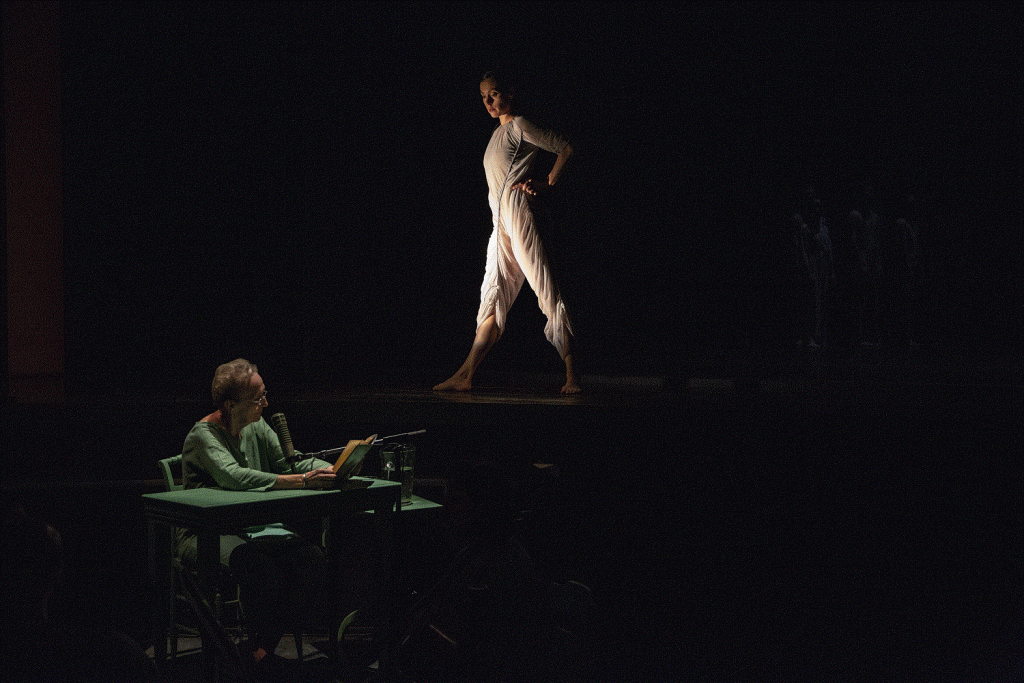
Kathleen Chalfant and Melissa Toogood in Four Quartets – Choreography by Pam Tanowitz – Photo by Maria Baranova
The costumes by designers Reid Bartelme and Harriet Jung gave the dancers an eerie effervescence and an aura of unbridled spirituality.
The truly stunning cast of Four Quartets who retained a sense of serenity and separation throughout were Kara Chan, Jason Collins, Dylan Crossman, Christine Flores, Zachary Gonder, Lindsey, Jones, Victor Lozano, Maile Okamura, and Melissa Toogood.
Written by Jeff Slayton for LA Dance Chronicle, February 17, 2020.
To visit the Pam Tanowitz Dance website, click here.
For more information on CAP UCLA, click here.
Featured image: Pam Tanoaitz Dance in Four Quartets – Photo by Maria Baranova

